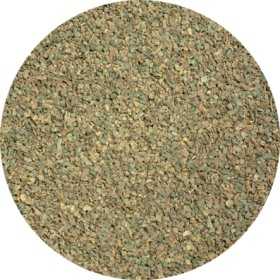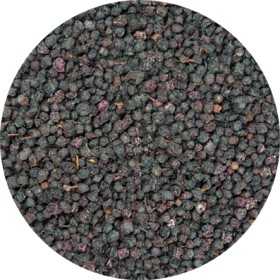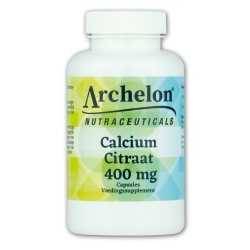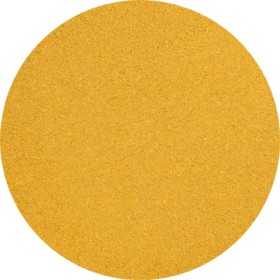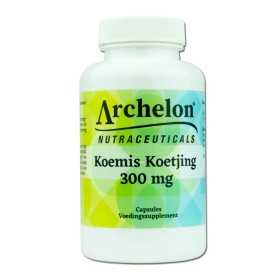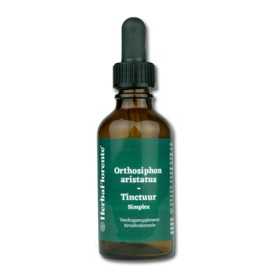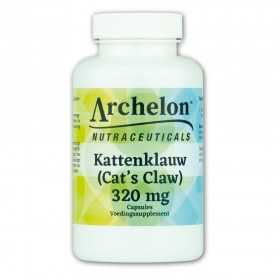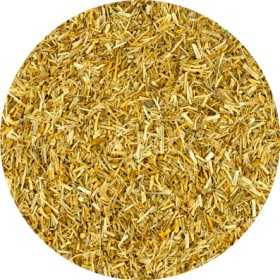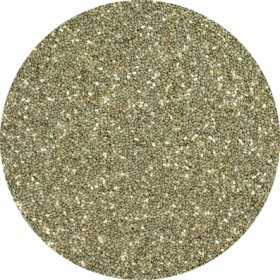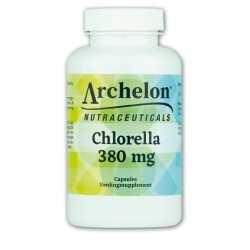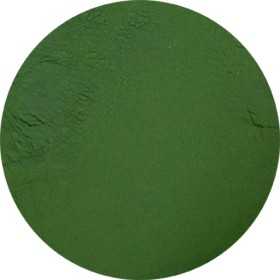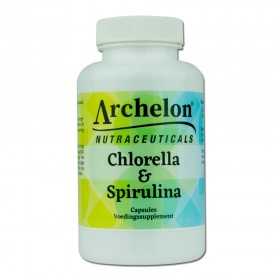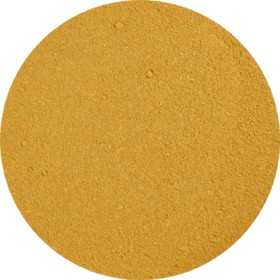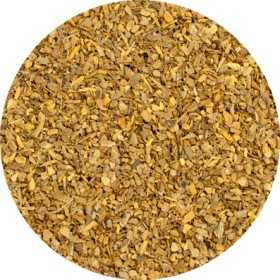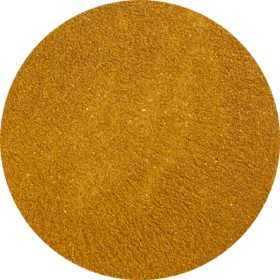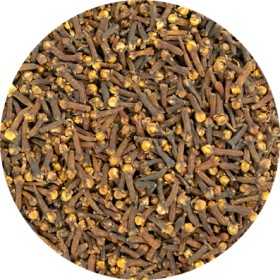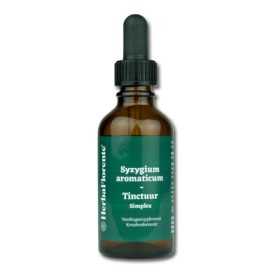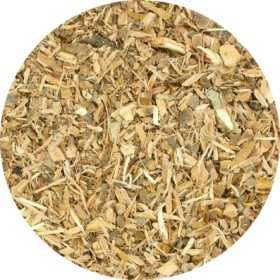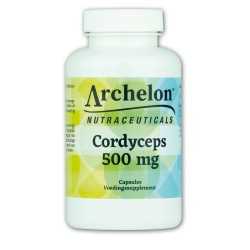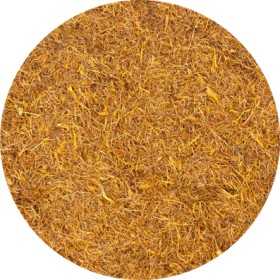Blood circulation
There are 214 products.
Bladderwrack Fine - Fucus vesiculosus
Bladderwrack (Fucus vesiculosus) is a type of brown algae belonging to the genus Fucus. It thrives along the northern coasts of the Atlantic and Pacific Oceans, and in the North Sea and Baltic Sea, often found in kelp forests. This seaweed is characterized by air bladders that serve as a floating organ, although there are also variants without these bladders.
Like other brown algae, bladderwrack is rich in a specific class of polyphenols called phlorotannins, which possess powerful antioxidant properties. In addition, these phlorotannins have antibiotic, antifungal and anti-inflammatory properties.
Like other brown algae, bladderwrack is rich in a specific class of polyphenols called phlorotannins, which possess powerful antioxidant properties. In addition, these phlorotannins have antibiotic, antifungal and anti-inflammatory properties.
€2.50
From: €2.50
Blue Berrie - Vaccinium mytrillus, Frucus myrtilli
The blueberry (Vaccinium myrtillus) is not only nutritious, but also extremely popular. These berries are extremely low in calories and are often labeled as a superfood. Although low in calories, blueberries are packed with beneficial nutrients, including antioxidants like flavonoids and anthocyanins.
Additionally, they contain a wide range of other compounds, including folic acid, vitamins A and C, carotenoids, ellagic acid and fiber. The specific anthocyanins in blueberries contribute to normal eye function and provide support to the heart and blood vessels.
Additionally, they contain a wide range of other compounds, including folic acid, vitamins A and C, carotenoids, ellagic acid and fiber. The specific anthocyanins in blueberries contribute to normal eye function and provide support to the heart and blood vessels.
€8.20
From: €8.20
Calcium Bisglycinate - 480 mg
Calcium is available in different forms, one of the better forms being calcium bisglycinate. Calcium bisglycinate has good bioavailability. It is a chelated form of calcium bound to two (bis) molecules of the amino acid glycine, which has more benefits for the body. Calcium is also involved in many body processes, including blood clotting, energy metabolism, muscles, bones, teeth, digestion, nervous system and cell division.
Today, many minerals are available in their inorganic form as nutritional supplements, such as oxides, carbonates and sulphates. However, these forms are poorly absorbed by our body. In nature, minerals occur in bioavailable forms, packaged in proteins, to prevent them from binding to other food components. This significantly increases their bioavailability.
Today, many minerals are available in their inorganic form as nutritional supplements, such as oxides, carbonates and sulphates. However, these forms are poorly absorbed by our body. In nature, minerals occur in bioavailable forms, packaged in proteins, to prevent them from binding to other food components. This significantly increases their bioavailability.
€23.95
Calcium Citrate - 400 mg
Calcium is available in various forms including calcium citrate and the even better form calcium bisglycinate. Calcium bisglycinate has good bioavailability. It is a chelated form of calcium bound to two (bis) molecules of the amino acid glycine which has more benefits for the body. Calcium is also involved in many body processes including blood clotting, energy metabolism, muscles, bones, teeth, digestion, nervous system and cell division.
€17.95
Cat's Claw - Uncaria tomentosa
Cat's claw (Uncaria tomentosa) is a climbing plant that is native to the Amazon region of Brazil and Peru. It is highly valued in the Peruvian Amazon and is among the protected species. This plant is often called the 'sacred herb of the rainforest' because of its significance. The name 'cat's claw' or 'cat's claw' is derived from the small claw-like thorns at the base of the leaves, which resemble a cat's claws. These claws help the vine to wrap itself around trees and climb up to a hundred meters high!
€2.60
From: €2.60
Cat's Claw - Uncaria tomentosa - Cut
Cat's claw (Uncaria tomentosa) is a climbing plant that is native to the Amazon region of Brazil and Peru. It is highly valued in the Peruvian Amazon and is among the protected species. This plant is often called the 'sacred herb of the rainforest' because of its significance. The name 'cat's claw' or 'cat's claw' is derived from the small claw-like thorns at the base of the leaves, which resemble a cat's claws. These claws help the vine to wrap itself around trees and climb up to a hundred meters high!
€2.20
From: €2.20
Cat's Claw Tincture - Uncaria tomentosa Tincture
Single herbal tincture made with dried bark of Uncaria tomentosa (Cat's Claw).
Although the West has only recently discovered the benefits of this herb, many cultures native to the Amazon rainforest have been using cat's claw for centuries. It is known for its ability to keep joints flexible and to support the human body's immune system. The active ingredients of cat's claw are alkaloids, tannins and various other phytochemicals. Research has shown that some of these alkaloids can support the immune system.
Although the West has only recently discovered the benefits of this herb, many cultures native to the Amazon rainforest have been using cat's claw for centuries. It is known for its ability to keep joints flexible and to support the human body's immune system. The active ingredients of cat's claw are alkaloids, tannins and various other phytochemicals. Research has shown that some of these alkaloids can support the immune system.
€9.95
Cat's whiskers - Koemis Koetjing - 300 mg
Cat's whisker (Orthosiphon aristatus), also known as Kumis Kutjing, has played an important role in Ayurvedic medicine for centuries due to its beneficial properties in treating urinary tract infections.
This plant belongs to the Lamiaceae family and thrives mainly in tropical and subtropical regions, preferring locations such as wetlands, along rivers and swamps, especially in Southeast Asia, especially Malaysia and Java. The name "cat's whisker" is derived from the white or lilac flowers with striking, thread-like stamens, sometimes up to 3 cm long.
This plant belongs to the Lamiaceae family and thrives mainly in tropical and subtropical regions, preferring locations such as wetlands, along rivers and swamps, especially in Southeast Asia, especially Malaysia and Java. The name "cat's whisker" is derived from the white or lilac flowers with striking, thread-like stamens, sometimes up to 3 cm long.
€19.95
Cat's whiskers Tincture - Orthosiphon aristatus Tincture
Single herbal tincture made with dried herb of Orthosiphon aristatus (Cat's whiskers).
Cat's whisker (Orthosiphon aristatus), also known as Kumis Kutjing, has played an important role in Ayurvedic medicine for centuries due to its beneficial properties in treating urinary tract infections.
This plant belongs to the Lamiaceae family and thrives mainly in tropical and subtropical regions, preferring locations such as wetlands, along rivers and swamps, especially in Southeast Asia, especially Malaysia and Java. The name "cat's whisker" is derived from the white or lilac flowers with striking, thread-like stamens, sometimes up to 3 cm long.
Cat's whisker (Orthosiphon aristatus), also known as Kumis Kutjing, has played an important role in Ayurvedic medicine for centuries due to its beneficial properties in treating urinary tract infections.
This plant belongs to the Lamiaceae family and thrives mainly in tropical and subtropical regions, preferring locations such as wetlands, along rivers and swamps, especially in Southeast Asia, especially Malaysia and Java. The name "cat's whisker" is derived from the white or lilac flowers with striking, thread-like stamens, sometimes up to 3 cm long.
€10.95
Cat’s Claw - 320 mg
Cat's claw (Uncaria tomentosa) is a climbing plant that is native to the Amazon region of Brazil and Peru. It is highly valued in the Peruvian Amazon and is among the protected species. This plant is often called the 'sacred herb of the rainforest' because of its significance. The name 'cat's claw' or 'cat's claw' is derived from the small claw-like thorns at the base of the leaves, which resemble a cat's claws. These claws help the vine to wrap itself around trees and climb up to a hundred meters high!
€19.95
Centaury - Centaurium erythraea
Centaury, also known by the scientific name Centaurium (synonym: Erythraea), includes about fifty species of herbaceous plants belonging to the gentian family (Gentianaceae). The genus may have been named after the centaur Chiron from Greek mythology, who was known for his knowledge of medicinal herbs and reportedly treated his wounds with this herb. An alternative explanation for the botanical name is derived from the Latin 'centum' (= one hundred) and 'aurum' (= gold).
In North America, the European centaury is sometimes cultivated as a medicinal plant and has been partly introduced as an exotic plant. The herb contains various bitter substances, glycosides, flavonoids, essential oils, valeric acid and xanthones.
In North America, the European centaury is sometimes cultivated as a medicinal plant and has been partly introduced as an exotic plant. The herb contains various bitter substances, glycosides, flavonoids, essential oils, valeric acid and xanthones.
€2.50
From: €2.50
Chia seeds - Salviae Sem. Hispanica nigri albi
Chia, also known as Salvia hispanica, is a plant from the Lamiaceae family, originally from central and southern Mexico and Guatemala. The Aztecs cultivated this plant even before Columbus discovered America, and chia seeds were used as currency to the rulers. Today, chia is still prized in Mexico and Guatemala; the ground seeds are used in dishes, while whole seeds are often added to nutritious drinks.
The main purpose of growing chia is for its seeds, which are rich in omega-3 fatty acids. About 25-30% of the seed contains vegetable oil, including alpha-linolenic acid (ALA). Chia seeds are small and oval, about 1 mm in diameter, and have a color palette of brown, gray-black and white.
The main purpose of growing chia is for its seeds, which are rich in omega-3 fatty acids. About 25-30% of the seed contains vegetable oil, including alpha-linolenic acid (ALA). Chia seeds are small and oval, about 1 mm in diameter, and have a color palette of brown, gray-black and white.
€2.00
From: €2.00
Chlorella - 380 mg
Chlorella, a single-celled green algae belonging to the green algae family, thrives in lakes and rivers of Southeast Asia. This microscopic organism is a veritable treasure trove of nutrients, including proteins, vitamins, trace elements and omega-3 fatty acids.
Its versatility is reflected in supporting the immune system and promoting liver detoxification. Chlorella also contributes to healthy digestion and supports normal intestinal function. The name 'chlorella' has its origins in the Greek words 'chloros' and 'ella', which mean 'green' and 'small' respectively.
Its versatility is reflected in supporting the immune system and promoting liver detoxification. Chlorella also contributes to healthy digestion and supports normal intestinal function. The name 'chlorella' has its origins in the Greek words 'chloros' and 'ella', which mean 'green' and 'small' respectively.
€17.95
Chlorella - Chlorella
Chlorella, a single-celled green algae belonging to the green algae family, thrives in lakes and rivers of Southeast Asia. This microscopic organism is a veritable treasure trove of nutrients, including proteins, vitamins, trace elements and omega-3 fatty acids.
Its versatility is reflected in supporting the immune system and promoting liver detoxification. Chlorella also contributes to healthy digestion and supports normal intestinal function. The name 'chlorella' has its origins in the Greek words 'chloros' and 'ella', which mean 'green' and 'small' respectively.
Its versatility is reflected in supporting the immune system and promoting liver detoxification. Chlorella also contributes to healthy digestion and supports normal intestinal function. The name 'chlorella' has its origins in the Greek words 'chloros' and 'ella', which mean 'green' and 'small' respectively.
€4.60
From: €4.60
Chlorella 200 mg & Spirulina 200 mg
Discover the power of the combination of chlorella and spirulina. They are packed with essential nutrients such as proteins, vitamins and minerals, and are known for their detoxifying properties and supporting overall health. Together, these super algae form a powerful synergistic blend that supports vitality, the immune system, the body and mind for optimal health and well-being. Feel the power of the natural resources in every capsule.
€19.95
Cinnamon - Cinnamomi ceylon
Cinnamon (Cinnamomum) has been known for centuries for its many uses. It is extracted from the bark of the Cinnamomum cassia tree, where part of the bark is carefully cut loose and the rough outer surface is removed with a knife. The well-known cinnamon sticks or cinnamon powder are made from the inside of the bark. Cinnamon has been valued for centuries, both in culinary and herbalist circles.
This herb has been used in Asian cultures for centuries for its versatile uses. The wonderful aroma of cinnamon is determined by volatile oils, of which cinnamaldehyde is the most common. In addition, cinnamon also contains substances such as eugenol, coumarins, tannins, OPCs and terpenes.
This herb has been used in Asian cultures for centuries for its versatile uses. The wonderful aroma of cinnamon is determined by volatile oils, of which cinnamaldehyde is the most common. In addition, cinnamon also contains substances such as eugenol, coumarins, tannins, OPCs and terpenes.
€2.95
From: €2.95
Cinnamon - Cinnamomi ceylon - Cut
Cinnamon (Cinnamomum) has been known for centuries for its many uses. It is extracted from the bark of the Cinnamomum verum tree, where part of the bark is carefully cut loose and the rough outer surface is removed with a knife. The well-known cinnamon sticks or cinnamon powder are made from the inside of the bark. Cinnamon has been valued for centuries, both in culinary and herbalist circles.
This herb has been used in Asian cultures for centuries for its versatile uses. The wonderful aroma of cinnamon is determined by volatile oils, of which cinnamaldehyde is the most common. In addition, cinnamon also contains substances such as eugenol, coumarins, tannins, OPCs and terpenes.
This herb has been used in Asian cultures for centuries for its versatile uses. The wonderful aroma of cinnamon is determined by volatile oils, of which cinnamaldehyde is the most common. In addition, cinnamon also contains substances such as eugenol, coumarins, tannins, OPCs and terpenes.
€3.00
From: €3.00
Citrus Blend Herbal Tea
Herbal tea composed of various herbs
Delicious for every moment
Delicious for every moment
€3.95
Clove - Syzygium aromaticum
Clove (Syzygium aromaticum) is the dried, fragrant flower bud of the clove tree. The main active ingredient is eugenol, which also promotes the antioxidant properties of cloves. Clove is known for its antioxidant effect and supports healthy digestion. In addition, it improves blood circulation and soothes the throat.
€3.10
From: €3.10
Clove - Syzygium aromaticum - Whole
Clove (Syzygium aromaticum) is the dried, fragrant flower bud of the clove tree. The main active ingredient is eugenol, which also promotes the antioxidant properties of cloves. Clove is known for its antioxidant effect and supports healthy digestion. In addition, it improves blood circulation and soothes the throat.
€3.00
From: €3.00
Clove Tincture - Syzygium aromaticum Tincture
Single herbal tincture made with dried flower of Syzygium aromaticum (Clove).
Clove (Syzygium aromaticum) is the dried, fragrant flower bud of the clove tree. The main active ingredient is eugenol, which also promotes the antioxidant properties of cloves. Clove is known for its antioxidant effect and supports healthy digestion. In addition, it improves blood circulation and soothes the throat.
Clove (Syzygium aromaticum) is the dried, fragrant flower bud of the clove tree. The main active ingredient is eugenol, which also promotes the antioxidant properties of cloves. Clove is known for its antioxidant effect and supports healthy digestion. In addition, it improves blood circulation and soothes the throat.
€10.95
copy of Witch Hazel (Bark) - Hamamelis virginiana
The American witch hazel (Hamamelis virginiana) is a shrub belonging to the family Hamamelidaceae, native to North America from Nova Scotia to Minnesota, and from southern and central Florida to eastern Texas.
The shrub can reach a height of 6 to sometimes even 10 meters, with a bushy growth thanks to the many branches that arise just above the ground. The bark is light brown, smooth but somewhat flaky, and shows a reddish-purple color on the inside.
Blooming from September through October, the flowers of the American witch hazel display clusters of 4 stamens. They usually range from pale yellow to bright yellow, although orange or red hues also occur. The petals are ribbon-shaped and measure 10-20 mm in length.
The shrub can reach a height of 6 to sometimes even 10 meters, with a bushy growth thanks to the many branches that arise just above the ground. The bark is light brown, smooth but somewhat flaky, and shows a reddish-purple color on the inside.
Blooming from September through October, the flowers of the American witch hazel display clusters of 4 stamens. They usually range from pale yellow to bright yellow, although orange or red hues also occur. The petals are ribbon-shaped and measure 10-20 mm in length.
€5.20
From: €5.20
Cordyceps - 500 mg
Cordyceps originates in the Far East and is widely used in Chinese herbalism. Cordyceps sinensis, also known as the caterpillar fungus, is a mushroom with a wide range of active substances and is therefore used for various purposes.
In traditional Chinese herbalism, cordyceps is even called the 'emperor of the mushrooms'. This fungus lives as a parasite on caterpillars of a specific moth species. It infects the caterpillars with its spores, after which a club-shaped mushroom grows from the head of the mummified caterpillar. The name 'cordyceps' comes from the Latin 'cordy' (club) and 'ceps' (head), while 'sinensis' means 'Chinese'. In the Netherlands, this fungus is also known as 'caterpillar killer', 'caterpillar fungus' or 'Chinese caterpillar killer'.
In traditional Chinese herbalism, cordyceps is even called the 'emperor of the mushrooms'. This fungus lives as a parasite on caterpillars of a specific moth species. It infects the caterpillars with its spores, after which a club-shaped mushroom grows from the head of the mummified caterpillar. The name 'cordyceps' comes from the Latin 'cordy' (club) and 'ceps' (head), while 'sinensis' means 'Chinese'. In the Netherlands, this fungus is also known as 'caterpillar killer', 'caterpillar fungus' or 'Chinese caterpillar killer'.
€34.95
Corn Silk - Zea mays Conc.
Dried corn silk, also called stigmas, are used in herbal medicine. When fresh, these hairs are green in color, but once dried they turn dark brown to black.
Corn silk, also known as corn beard, can have beneficial effects on fluid balance, bladder inflammation (soothing) and irritation of the urinary tract (soothing).
Corn silk, also known as corn beard, can have beneficial effects on fluid balance, bladder inflammation (soothing) and irritation of the urinary tract (soothing).
€2.00
From: €2.00















